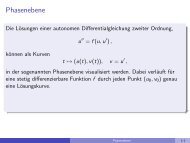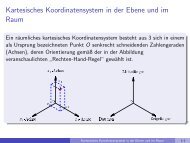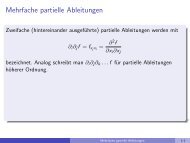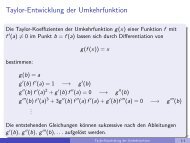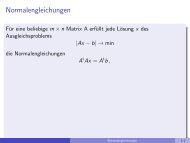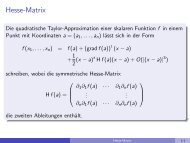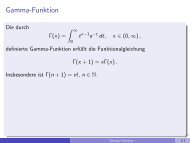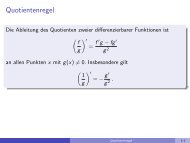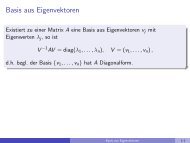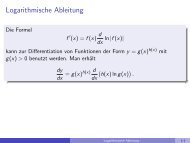Rationale Funktion - imng
Rationale Funktion - imng
Rationale Funktion - imng
Sie wollen auch ein ePaper? Erhöhen Sie die Reichweite Ihrer Titel.
YUMPU macht aus Druck-PDFs automatisch weboptimierte ePaper, die Google liebt.
<strong>Rationale</strong> <strong>Funktion</strong><br />
Eine rationale <strong>Funktion</strong> r mit Zählergrad m und Nennergrad n ist der<br />
Quotient zweier Polynome:<br />
r(x) = p(x)<br />
q(x) = a 0 + a 1 x + · · · + a m x m<br />
b 0 + b 1 x + · · · + b n x n .<br />
Diese Darstellung bezeichnet man als irreduzibel, wenn p und q keinen<br />
gemeinsamen Linearfaktor besitzen. Die Nullstellen des Nenners sind dann<br />
Definitionslücken der rationalen <strong>Funktion</strong> r und werden als Polstellen<br />
bezeichnet. Ihre Ordnung entspricht der Vielfachheit der Nullstelle.<br />
<strong>Rationale</strong> <strong>Funktion</strong> - 1-1
<strong>Rationale</strong> <strong>Funktion</strong><br />
Eine rationale <strong>Funktion</strong> r mit Zählergrad m und Nennergrad n ist der<br />
Quotient zweier Polynome:<br />
r(x) = p(x)<br />
q(x) = a 0 + a 1 x + · · · + a m x m<br />
b 0 + b 1 x + · · · + b n x n .<br />
Diese Darstellung bezeichnet man als irreduzibel, wenn p und q keinen<br />
gemeinsamen Linearfaktor besitzen. Die Nullstellen des Nenners sind dann<br />
Definitionslücken der rationalen <strong>Funktion</strong> r und werden als Polstellen<br />
bezeichnet. Ihre Ordnung entspricht der Vielfachheit der Nullstelle.<br />
Die Variable x und die Koeffizienten a k , b k können reell oder komplex<br />
sein. Entsprechend spricht man von einer reellen oder komplexen<br />
rationalen <strong>Funktion</strong>.<br />
<strong>Rationale</strong> <strong>Funktion</strong> - 1-2
Beispiel:<br />
PSfrag<br />
f (x) =<br />
x 4<br />
(x + 1)(x − 1) 2<br />
6<br />
4<br />
2<br />
0<br />
−2<br />
−4<br />
−6<br />
−6 −4 −2 0 2 4 6<br />
<strong>Rationale</strong> <strong>Funktion</strong> - 2-1
Beispiel:<br />
PSfrag<br />
f (x) =<br />
x 4<br />
(x + 1)(x − 1) 2<br />
6<br />
4<br />
2<br />
0<br />
−2<br />
−4<br />
−6<br />
−6 −4 −2 0 2 4 6<br />
einfacher Pol bei x = −1 Vorzeichenwechsel<br />
<strong>Rationale</strong> <strong>Funktion</strong> - 2-2
Beispiel:<br />
PSfrag<br />
f (x) =<br />
x 4<br />
(x + 1)(x − 1) 2<br />
6<br />
4<br />
2<br />
0<br />
−2<br />
−4<br />
−6<br />
−6 −4 −2 0 2 4 6<br />
einfacher Pol bei x = −1 Vorzeichenwechsel<br />
doppelter Pol bei x = 1 kein Vorzeichenwechsel<br />
<strong>Rationale</strong> <strong>Funktion</strong> - 2-3
Beispiel:<br />
Visualisierung des Real- und Imaginärteils von<br />
r(z) =<br />
z2<br />
z 3 − 1<br />
<strong>Rationale</strong> <strong>Funktion</strong> - 3-1
Beispiel:<br />
Visualisierung des Real- und Imaginärteils von<br />
r(z) =<br />
z2<br />
z 3 − 1<br />
Polstellen auf dem Einheitskreis:<br />
z 1 = 1, z 2 = e 2πi/3 = − 1 2 + √<br />
3<br />
2 i, z 3 = e −2πi/3 = − 1 2 − √<br />
3<br />
2 i<br />
<strong>Rationale</strong> <strong>Funktion</strong> - 3-2





